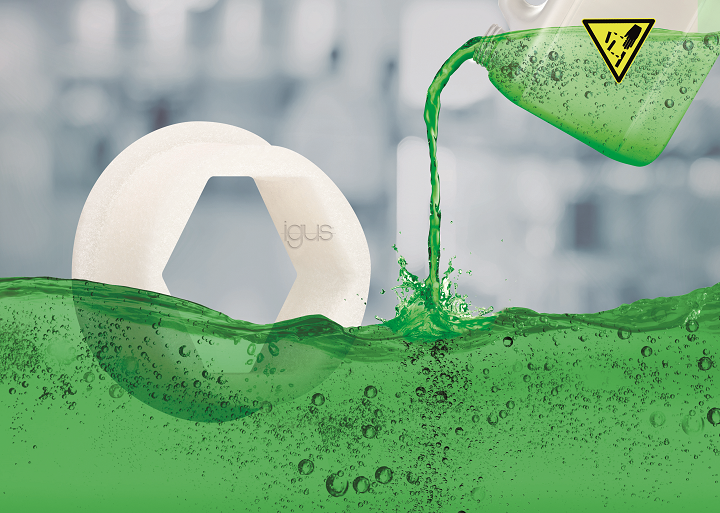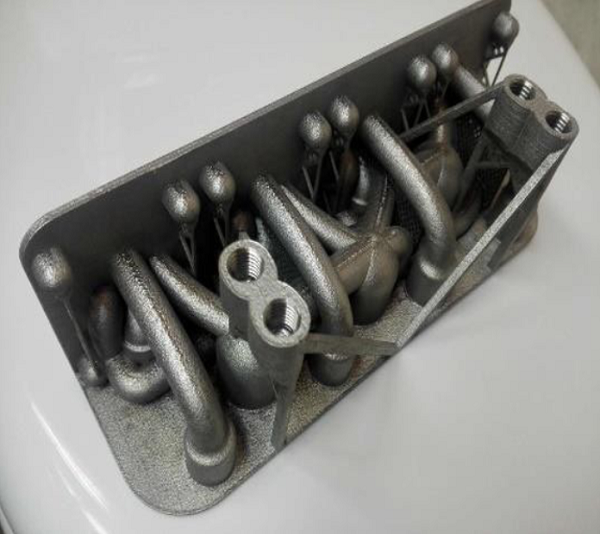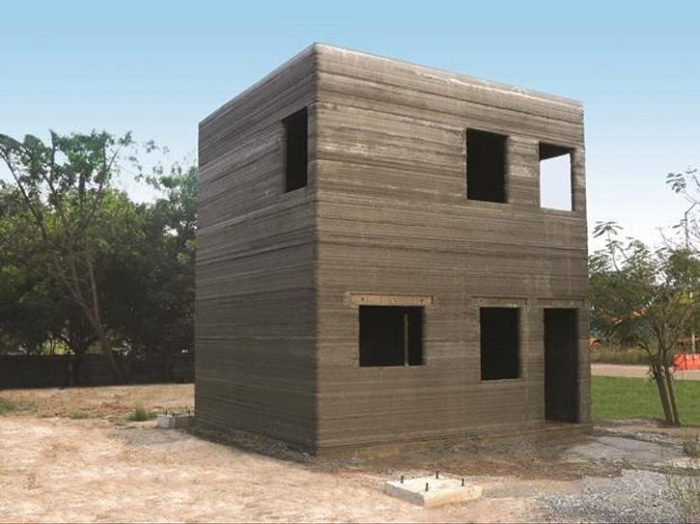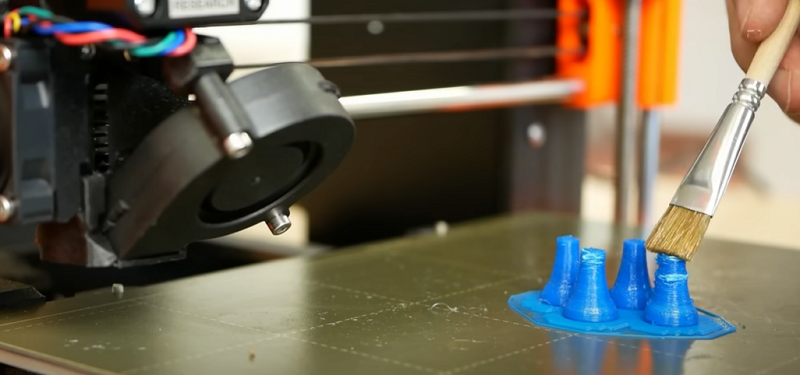3D Printing News Briefs, September 21, 2022: 3D Printed Post Office, Hydraulics, Layer Adhesion, & More
We’re starting with the first 3D printed post office in India in today’s 3D Printing News Briefs, and then moving on to materials, as a new laser sintering material from igus makes it possible to 3D print chemical-resistant components. A researcher from Zhejiang University is working with Eplus3D on metal 3D printing being used to make hydraulic components. The CNC Kitchen investigates if solvent can glue individual layers of a 3D print together. Finally, Framework has been forced to change its 3D printed mini PC case.
India’s First 3D Printed Post Office
Within a month, the first 3D printed post office in India should be opening in Bengaluru, the capital of Karnataka. The complete three-story concrete building will be located at Cambridge Layout in Halasuru, and has already received clearances by the Building Materials and Technology Promotion Council of the Ministry of Housing and Urban Affairs and IIT-Madras. According to S Rajendra Kumar, Chief Post Master General of the Karnataka Circle, using 3D printing to fabricate the post office will cut construction costs in half, and majorly speed up the building process as well.
The 3D printed post office building is being constructed by L&T, which is one of the only companies in India, in addition to Tvasta, that’s currently using additive construction. In late 2020, L&T 3D printed a 700 square foot building with reinforcement for the first time in India, so it seems like a good company for the task of 3D printing a three-story post office.
igus Offering Chemical-Resistant SLS 3D Printing Material
 Chemical-resistant, self-lubricating, and maintenance-free: with the new iglide i10 laser sintering 3D printing material, customers quickly get their prototypes and small production volumes.
Chemical-resistant, self-lubricating, and maintenance-free: with the new iglide i10 laser sintering 3D printing material, customers quickly get their prototypes and small production volumes.German motion plastics company igus is now offering a new material for selective laser sintering (SLS) 3D printers, called iglide i10, that can be used to create chemical-resistant, self-lubricating, tribo-polymer components. This high-performance plastic complies with EU Regulation 10/2011, which certifies that it’s harmless in contact with food, and is also FDA-compliant, as well as being resistant to acids, alcohols, bases, oils, and greases; these certifications and material properties make it a great choice for 3D printing components in the food processing and electroplating industries. In addition, its low moisture absorption and high ductility mean iglide i10 can be used to print industrial functional components with elastic properties. igus will offer the new material through its in-house 3D printing service, which means that customers could receive 3D printed components just five days after the company received the order.
“The process has the advantage that it requires no tools and is significantly more cost-effective and faster than traditional processes such as injection molding,” explained Tom Krause, Head of Additive Manufacturing at igus. “This is especially true for prototypes and small production volumes.”
Eplus3D Using Metal AM for Valve Design & Manufacturing
 3D printed metal hydraulic manifolds
3D printed metal hydraulic manifoldsDr. Zhu Yi, Associate Professor in the School of Mechanical Engineering, Zhejiang University, works in the university’s Metal Additive Manufacturing Laboratory, and is researching how metal powder bed fusion can be applied to enable innovative design of hydraulic components. The team he leads is working with Eplus3D on this research. Valves, which control the direction, flow, and pressure of fluids, are an important controlling part of the fluid power systems, and are used in a wide variety of mechanical products in many industries. Hydraulic valve manifolds are complex, with complicated inlet arrangements and internal passages that cross over each other. Traditionally, these parts require a hole to be drilled for the internally-crossed passages, and later the hole has to be blocked with screw plugs, but leakage is still a possibility. Additionally, drilled internal passageways are straight, with 90° turns, and Computational Fluid Dynamics (CFD) analysis shows that some areas have less flow this way.
Working with Eplus3D, the university team used metal 3D printing to redesign the runner structure and interface layout of traditional hydraulic manifolds, which has resulted in several positive changes. First, the weight of these manifolds has been reduced by 35%, from 1.5 kg down to just 0.98 kg, while the volume was reduced by up to 78%. Additionally, by changing the right angle intersection flow path to a smoother arc transition, the flow characteristics in the hydraulic valve manifold were improved, as local pressure loss is reduced when oil passes through. Finally, the risk of leakage goes down, and the stability and performance of the valve go up, because no additional process drilling is needed when you use 3D printing to fabricate the complex integrated structure.
Can Solvent on Each Print Layer Result in Perfect Adhesion?
In a new video sponsored by PrusaResearch, the CNC Kitchen YouTube channel points out a major 3D printing weakness—prints are strong if they are loaded along their layers, but typically much weaker if they’re loaded in between layers. This can be improved by slower print speeds, higher extrusion temperatures, less cooling, and more, but solvents can also be used to glue prints together made out of certain materials, such as ABS. CNC Kitchen wondered if they could also glue together a print’s individual layers by brushing acetone on each individual one before the next layer begins printing—thus creating perfectly strong prints. This seems like it would take an annoyingly long time to me, but if it works, it works, right? Unfortunately, CNC Kitchen’s experiment did not deliver great results.
“Even though layer bonding sounds very exciting, it’s not as simple as it would seem, and my first proof of concept results were not very promising. I’m not saying that my process was perfect, because it wasn’t automated, and maybe even after two days in a dehydrator, not all the solvent might have been removed from the samples. But would such a method really be feasible if you had to force dry parts for several days or even weeks after printing?”
Check out the full video below if you’re interested in the process, and think you could do better:
Lenovo Tells Framework to Change 3D Printed Mini PC Case
 The first iteration of the Framework ‘Desktop’ has been cut short by Lenovo. (Image source: Framework)
The first iteration of the Framework ‘Desktop’ has been cut short by Lenovo. (Image source: Framework)US-based laptop manufacturer Framework now lets its laptop owners to use a 3D printed case to turn their old motherboards into a mini PC, which is pretty cool. But, lawyers for consumer electronics company Lenovo reached out pretty quickly to claim infringement, because it believes that the design for the Framework case’s power button is too similar to its own Legion logo. Framework made this logo because most 3D printers aren’t capable of creating a floating power button, but Lenovo says that the ‘Broken O Design’ of the case’s power button might lead people to believe that it’s related to the Lenovo Legion brand.
Instead of fighting back, Framework decided to turn lemons into lemonade, and held a competition, crowdfunding for a new logo from its fans. According to a Framework Twitter post, whoever designed the best new power button, as subjectively chosen by the company’s CEO, would receive a free Core i5-1135G7-powered motherboard. The winning designs for the new power button logo were recently announced, and you can see them in another Framework Tweet below:
The winning power buttons from @_tweedge and @thedarktigger are now up on GitHub: https://t.co/8yPdiyvpjt pic.twitter.com/RSGEjMp64c
— Framework (@FrameworkPuter) September 1, 2022
Subscribe to Our Email Newsletter
Stay up-to-date on all the latest news from the 3D printing industry and receive information and offers from third party vendors.
Print Services
Upload your 3D Models and get them printed quickly and efficiently.
You May Also Like
3D Printing News Briefs, June 11, 2025: Sustainability, Automotive Tooling, & More
We’re starting with sustainability news in today’s 3D Printing News Briefs, as EOS has strengthened its commitment on climate responsibility, and Zestep is making 3D printing filament out of eyewear...
3D Printing 50 Polymer Stand-In Parts for Tokamaks at the PPPL & Elytt Energy
Of all the world’s things, a tokamak is one of the hardest, most complex, expensive and exacting ones to make. These fusion energy devices make plasma, and use magnets to...
3D Printing News Briefs, May 17, 2025: Color-Changing Materials, Humanoid Robot, & More
We’re covering research innovations in today’s 3D Printing News Briefs! First, Penn Engineering developed 3D printed materials that change color under stress, and UC Berkeley researchers created an open source,...
Firehawk Aerospace Partners with JuggerBot 3D, Gets $1.25M from AFWERX for 3D Printed Propellants
Texas-based Firehawk Aerospace, an advanced energetic materials firm that works with aerospace and defense applications, announced a strategic partnership with JuggerBot 3D, an Ohio-based large-format 3D printer manufacturer. Together, the...



































